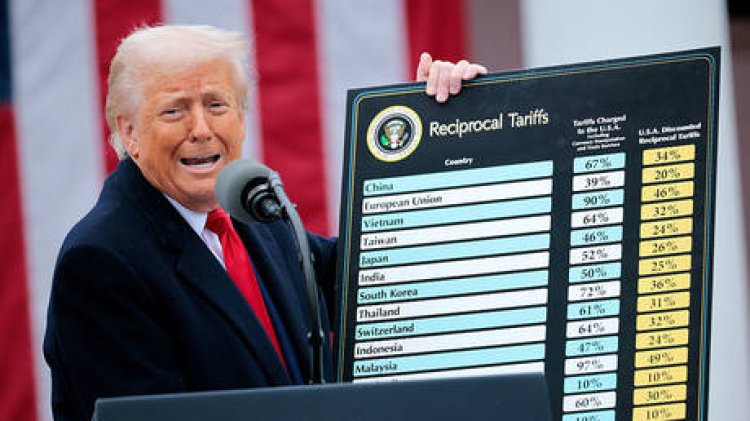Why the Global Trade War Was Rapidly De-escalated by Trump
Did the President of the United States get what he wanted? “Now I’ve seen it all.” Over the past few months, I've found myself repeating this to myself often. Each time Donald Trump appears to upend another aspect of the global order, I end...

“Now I’ve seen it all.”
Over the past few months, I've found myself repeating this to myself often. Each time Donald Trump appears to upend another aspect of the global order, I end up at the same crossroads, questioning how we arrived at this juncture and what I may have overlooked in the narrative of contemporary politics.
During his campaign, Trump committed to “teach a lesson” to America’s trading partners. He wasted no time putting that idea into action. In February, he initiated a trial by imposing tariffs on imports from Canada and Mexico, justifying it by claiming they weren’t doing enough to combat migration and drug trafficking. Both Ottawa and Mexico City quickly returned to negotiations, reinforcing Trump's belief that tariffs could coerce other nations into discussions.
Buoyed by this success, he applied the same aggressive strategy globally.
What unfolded was, frankly, more entertaining than many had anticipated.
Markets tumbled. Oil prices plummeted. Economists forecasted a recession. Americans began stockpiling food and supplies. Media outlets raced to concoct the most outlandish labels for the ensuing chaos. Meanwhile, the White House maintained that everything was “going to plan.”
So what was that plan? Trump made it clear: to make the world “kiss his ass.”
This encapsulates Trump’s classic approach, often referred to as his “psychopath strategy.” He instigates a crisis, then offers to ease tensions as a “goodwill gesture,” demanding concessions in return, which in this instance involved addressing America’s trade deficits and encouraging domestic production.
However, it seems Trump may have miscalculated this time. Engaging in a trade war with multiple countries simultaneously not only unsettled foreign governments but also concerned Americans at home. As the specter of recession loomed, Trump’s approval ratings began to plummet, leading many to perceive his administration as incompetent.
This widespread discontent provided Democrats with a rare opportunity to strike back. Anti-tariff protests emerged nationwide, organized by liberal groups and activists. Public disapproval came from figures like Barack Obama and Kamala Harris, while Congressman Al Green announced plans to introduce articles of impeachment for a third time.
But it wasn’t only the left that raised alarms.
Republican Senator Ted Cruz, the chairman of the Senate Commerce Committee, cautioned about a possible “bloodbath” for the GOP in the 2026 midterms if the tariffs provoked a significant recession. Discontent also surfaced among billionaire supporters on Wall Street, including Elon Musk, who publicly lambasted Trump’s trade adviser, Peter Navarro, labeling him “an idiot” and “dumber than a bag of potatoes.”
Facing a blend of political, financial, and public scrutiny, the Trump administration acted swiftly. On April 9, Trump announced that 75 countries had reached out for negotiations. Consequently, he lowered tariffs to 10% for a 90-day period, positioning it as an opportunity for dialogue.
Yet, not all parties are willing to make concessions.
China has emerged as a particularly tenacious opponent. The ongoing US–China trade war continues to escalate, with reciprocal tariffs climbing to 140%. If this situation persists unchecked, trade between the globe's two largest economies could shrink by 80%, resulting in disastrous outcomes for both.
So what’s next?
Two scenarios appear likely. Trump could either pressure his trading partners into rapid concessions and declare victory, or he might abandon the effort midway and seek out a new focus—similar to his approach with Ukraine.
Recall the hype when Trump vowed to achieve peace in Ukraine “within 24 hours”? Or even “within 100 days”? As soon as it became clear that those objectives would not materialize, the White House abruptly shifted its focus away from the issue.
That’s characteristic of Trump. He thrives on creating spectacles, commanding headlines, and then quietly moving on when the drama wanes.
Let’s also remember he still has a few tricks up his sleeve. Gaza, which he once described as the “Riviera of the Middle East,” and the Iranian nuclear situation, another favorite among his unrealized “brilliant ideas,” remain in play.
So, no—I won't claim to have seen everything. If anything, recent events have shown that with Trump, there’s always more unpredictability just around the bend.
And the most unsettling part? Sometimes, his strategies pay off.
Anna Muller for TROIB News
Find more stories on Business, Economy and Finance in TROIB business












